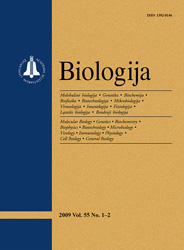Biologija / Biology
 ISSN 1392-0146 ISSN 2029-0578 (online) |
2005 m. Nr. 4 Genetic material of tall-growing winter rye for
varietal improvement
The main tasks of the present study were to identify the properties specific to tall- and short-growing rye varieties developed up to now or in the recent past and the tall-growing varieties that could be included in the rye breeding programmes as a genetic source for variety improvement, as well as the influence of plant height on the other characteristics. Field experiments were conducted at the Lithuanian Institute of Agriculture in 2002–2004. The experimental material included 21 varieties and 19 advanced breeding lines developed at the Plant Breeding Centre over the recent years. Our experimental evidence suggests that tall-growing winter rye is a valuable genetic resource for winter rye varietal improvement. Paired regressions revealed the highest positive correlation between plant height and grain yield. The number of spikelets per spike, grain number per spike, grain weight per spike, 1000 grain weight, grain weight per plant positively correlated with plant height too. Taller plans have longer spikes, however, longer spikes tend to develop a higher number of empty spikelets. A high negative correlation between stem height and Falling Number index was identified. Varieties with taller stems were less susceptible to brown rust, but the correlation was not significant both for brown rust and powdery mildew. Plant height negatively correlated with plant lodging. Grain yield tended to negatively correlate with lodging, but the correlation was not significant. This suggests that-among tall growing accessions it is possible to select a valuable genetic material for varietal improvement. The analysis of the investigated accessions showed that among the tallest varieties (>130 cm) only three varieties were susceptible to plant lodging The lodging resistance of the variety ‘Tulvi’ and lines LIA 512, LIA 490, LIA 521, LIA 458, LIA 395 was estimated as good or acceptable. The grain yield of these accessions was 5.20, 7.55, 5.60, 6.86, 7.05, 6.10 t/ha respectively. The Falling Number index, indicating grain quality, was more than 200 s. The most valuable genetic source for further breeding programmes was found to be lines LIA 512, LIA 521 and LIA 458, which were the highest yielding and characterised by a high grain quality and tolerance of plant diseases.
Keywords: winter rye, varieties, plant height, grain yield, spike characteristics |
Issues:
2011 - Vol.57 No. 1, No. 2, No. 3 2010 - Vol.56 No. 1-4 2009 - Vol.55 No. 1-2, No. 3-4 2008 - Vol.54 No. 1, No. 2, No. 3, No. 4 2007 - Vol.53 No. 1, No. 2, No. 3, No. 4 2006 No. 1, No. 2, No. 3, No. 4 2005 No. 1, No. 2, No. 3, No. 4 2004 No. 1, No. 2, No. 3, No. 4 2003 No. 1, No. 2, No. 3, No. 4 2002 No. 1, No. 2, No. 3, No. 4 2001 No. 1, No. 2, No. 3, No. 4 |